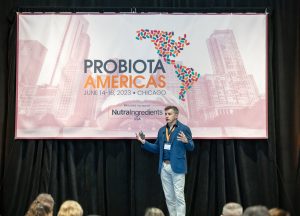ISAPP elaborates criteria for prebiotics

Co-authored by Prof. Bob Hutkins PhD & Prof. Karen Scott PhD
Nearly one in four Americans say digestive health is the most important aspect of their overall health, according to a 2022 International Food Information Council survey. Prebiotics – a 30-year old concept – are growing in popularity among consumers interested in digestive health, although knowledge of what they are and what they do varies. For example, 18% of American consumers have never heard of prebiotics, while 22% state they are familiar with and actively try to consume them. Those consumers who say they are ‘familiar’ with prebiotics look for them in yogurt or kefir, where they are typically not found, but also in fruits and vegetables or dietary supplements, where they may be present.
Although clearly there is a need for scientifically sound information for consumers, experts recognize that a gap in understanding exists even for scientists. To help bring some clarity to the scientific principles involved in prebiotics, a group of scientists collaborated on an Expert Recommendation published October 2, 2024 in Nature Reviews Gastroenterology and Hepatology. This paper, titled “Classifying compounds as prebiotics—scientific perspectives and recommendations”, delineated what prebiotics are and what lines of research are needed to establish their status.
This paper reinforces the 2017 definition of prebiotic, “a substrate that is selectively utilized by host microorganisms conferring a health benefit”. It further breaks down the individual criteria that are explicitly and implicitly derived from this definition, summarized in the table below. Neither ISAPP nor the authors of this paper claim to be the arbiters of whether or not a given substance satisfies the prebiotic definition. Rather, the primary motivation for this effort was to provide researchers clearly stated criteria that aid the development of the scientific rationale for concluding that a newly proposed substance can be legitimately termed a ‘prebiotic’. In transitioning ’candidate prebiotics’ to accepted prebiotics, it is important that proposed compounds meet all aspects of the prebiotic definition. In parallel, ISAPP developed a companion prebiotic checklist.
Perhaps the most challenging issue the authors addressed was defining selectivity. Although the idea that distinct components of the microbiota respond to a prebiotic is fundamental to the prebiotic concept, the complexity of the microbiota makes such a response difficult to quantify. Selective utilization is measured by tracking prebiotic-induced changes in composition or function of the microbiota. Many different possible approaches to measuring microbial function and composition, which will continue to expand with methodological advances, inform these research efforts. The extent of the modulation could be narrow or broad, but it should be reproducible and specific. Importantly, a sound hypothesis for why any such microbiome changes would underpin the observed health effect should be advanced. The authors of this paper agreed with the importance of allowing innovation in the prebiotic field, and as such, were not prescriptive by specifying which specific analyses are required.
Unlike probiotics – where no mechanism of action leading to the health benefit is specified by the definition – the prebiotic definition stipulates one. A prebiotic-induced health benefit should derive from the modulation of the microbiome (composition or function) that is a result of selective utilization. To date, most studies on prebiotics have shown an association of microbiome modulation and the health benefit by tracking both in the same efficacy trial in the target host. Such a study shows that the health benefit and microbiome modulation are correlated, but it does not prove that the microbiome modulation causes the health benefit. Such proof is difficult to obtain, and therefore is not required for prebiotic status, a position consistent with the 2017 consensus paper. But this new paper reemphasizes the value of research to address causality, which remains a challenging issue in the microbiome field, and discusses statistical approaches that can increase confidence that the relationship is causal. Causality studies can be informed by a variety of methods, including mining relevant microbiome databases, in silico screening, in vitro and in vivo tracking of expression of microbiota-dependent metabolic pathways, machine learning, artificial intelligence, and animal models.
The authors anticipate that this paper will encourage scientists to coalesce their understanding of prebiotics around these concepts. As pointed out in the paper, “Adherence by all stakeholders to these criteria would benefit the prebiotic field by providing cohesion in prebiotic research, principles to underpin regulatory actions, and clarity to alleviate confusion for consumers.”
Table 1: Key criteria of a prebiotic derived from the ISAPP prebiotic definitiona (From Hutkins et al. 2024)
| Prebiotic criteria | Comments |
| Substrate | A prebiotic is a substance administered to a host and utilized by autochthonous microorganisms. It might be an ingredient in a diet, but ‘prebiotic’ refers to a specific substance rather than a complete diet. |
| Identity and characterization | Prebiotic must be sufficiently described to enable robust data comparisons and reproducible manufacture of the ingredient. |
| Selectively utilized by host microbiota | Selective utilization can be shown by one microbial change or a change in many taxa or by specific functional readouts. |
| Demonstrated health benefit | Type of health benefit endpoint assessed depends on intended regulatory category and must be demonstrated by well controlled studies (typically RCTs) in the target population. |
| Hypothesis for mechanism of how microbiome modulation might lead to the health benefit | A sound rationale should be developed explaining how the pattern of selective utilization by host microorganisms observed for the prebiotic could lead to the health benefit. |
| Health benefit in the target host must be demonstrated in the same study that demonstrates selective utilization by the microbiota | It is not essential to demonstrate a causal link between the selective utilization of the prebiotic and health benefit(s), as such evidence can be very difficult to obtain experimentally. However, research aimed at this goal is encouraged, aided by causal mediation design and analysis strategies. With regard to demonstrating the health benefit, animal studies in non-target hosts as well as in vitro studies might be useful to address mechanistic questions and to plan trials in the target host but cannot in isolation provide sufficient evidence to establish claimed health benefits in the target host. |
| Safe for intended use | Adverse events must be tracked in studies conducted in target host. Safety requirements differ for different regulatory categories and target populations. |
| Confirmatory evidence, beyond minimum requirements | Multiple studies demonstrating reproducibility of health effects and selective utilization increase confidence in outcomes. |
| Administered in dose or serving size shown to elicit health benefit and selective utilization by the host microbiota in controlled studies | Advice on serving size should be provided so that sufficient dose for health benefit is achieved without eliciting adverse effects, such as toxicity, gastrointestinal symptoms, or choking, among others. |
aBased on the ISAPP definition of prebiotic: a substrate that is selectively utilized by host microorganisms conferring a health benefit. Not all criteria are specifically stated in the definition, but are implicit in text in the accompanying paper.
The criteria within the paper are summarized in a downloadable prebiotic evidence checklist from ISAPP.
Join ISAPP’s upcoming webinar on this topic, with the date to be announced shortly. Sign up for the ISAPP newsletter or follow our social media platforms here to be notified of the date.
REFERENCE:
Hutkins R, Walter J, Gibson GR, Bedu-Ferrari C, Scott K, Tancredi DJ, Wijeyesekera A, Sanders ME. Classifying compounds as prebiotics – scientific perspectives and recommendations. Nat Rev Gastroenterol Hepatol. 2024. doi: 10.1038/s41575-024-00981-6.



